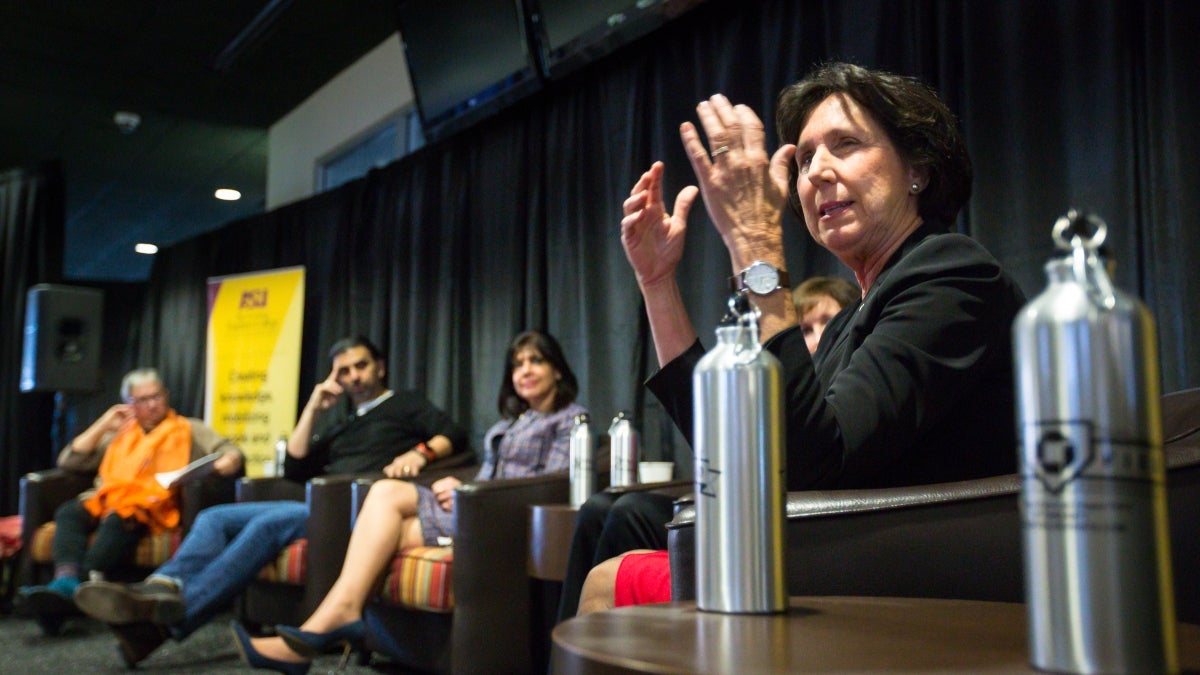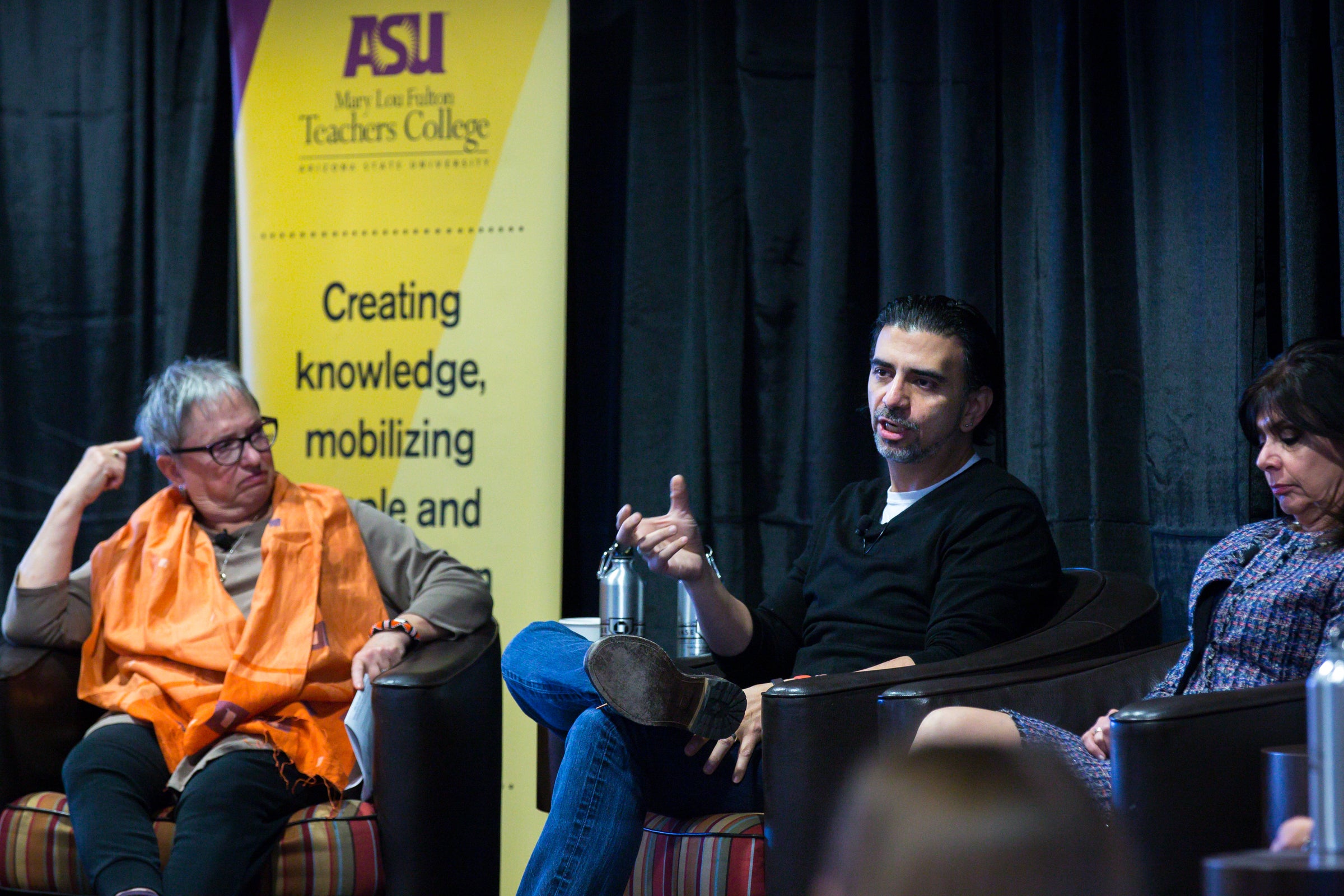Universities can be a key player in getting good education to poor students, and several experts said that innovation as promoted at Arizona State University is the way to do it.
The Mary Lou Fulton Teachers College explored the idea “Think Big” at its 10th annual summit, held Friday at Chase Field in Phoenix.
Mari Koerner, dean of the Teachers College, started out teaching poor students in Chicago, where her classroom was a trailer.
“It was a long time ago and we’re still talking about these issues. Why? To whose advantage is it that there are children who remain uneducated?”
Still, she said she’s optimistic.
“At no other time in history has there been the wealth and the education available to people in the U.S.,” she said at the panel discussion.
“People in America, especially in the Southwest, really think we can change things and that tomorrow will be better than today.
“We get so settled into our jobs that we don’t even realize we’re innovative,” she said.
Among the innovations in the Teachers College are the iTeachAZ preparation program, which places teacher candidates into classrooms with mentors and site coordinators for a full year rather than a semester, and a technology-infusion initiative.
That attitude of adaptation is key to improving equity, one education leader said.
“The door to that is the university,” said Patricia Tate, superintendent of the Osborn Elementary School District (shown in the photo above, at right). “It opens the door to disruption. When you have researchers knocking on the door saying, ‘Let’s try this, and I say ‘here’s the teacher.’
“I would never work in a district that was not connected to a university,” said Tate, whose district was in a classroom-technology partnership with ASU that provided iPads and teacher training.
The educators added that innovation doesn’t mean constant revolution.
“The definition of innovation is not the throw it out — it’s to make it better,” said Jaime CasapIn his role, Casap launched Google Apps for Education and he said ASU was the first university to participate. He also is an adjunct professor at ASU., whose title is chief education evangelist for Google.
“I talk to superintendents all over the country about giving teachers the space to try things and say, ‘This didn’t work but here’s my idea to make it better.’ "
Mari Koerner (left) dean of the Mary Lou Fulton Teachers College, leads a panel that includes Jaime Casap, chief education evangelist at Google, and Maria Harper-Marinick, executive vice chancellor of the Maricopa Community Colleges, at Chase Field in Phoenix Feb. 8. Photos by Charlie Leight/ASU Now
Phoenix Mayor Greg Stanton addressed the educators at the summit, and thanked them.
"What this school is doing, producing the top talent and motivating people who could make a lot more money doing other things but commiting their lives to children — the community and I owe you a huge debt."
The panelists said that for education to improve for all students, a change in attitude is required.
“The rational arguments don’t seem to move people,” said Jackie NortonNorton is former vice president of the Arizona State University Foundation and has a law degree from ASU., president and CEO of the Rodel Foundation of Arizona, which has programs to boost achievement in high-needs schools. “I think it’s the perception that not all kids deserve to be educated. There’s also a ‘deserving’ factor. ‘Are they here illegally? Are they paying taxes?’
“How do we get to peoples’ core beliefs? You can’t change them, but we can address them.”
Maria Harper-Marinick, executive vice chancellor and provost of the Maricopa Community Colleges, agreed.
“As long as we keep thinking ‘those kids’ and not ‘my kids,’ it won’t bring real equity,” she said.
“We need to bring equity without apology. It’s not about equality, it’s about equity. Some people need a little bit more.”
Harper-Marinick, who was born in the Dominican Republic and grew up in a dictatorship, said that support of public education throughout the entire spectrum is a key.
“There was no public education as we know it. I never had access to libraries,” said Harper-Marinick, who came to ASU on a Fulbright scholarship. “When I saw Hayden Library — six floors of books. That feeling of access to information without fear — knowing that nobody was going to jail if Maria was reading about — I can’t tell you the feeling of liberation that is. It’s the appreciation of the right to an education without fear.
“Funding K12, community colleges, the state’s public universities is a necessity because it’s the model that works.”
More Arts, humanities and education

A humanities link from Harvard to ASU
Jeffrey Wilson didn’t specifically seek out Arizona State University professors when it came to filling out the advisory board for his new journal Public Humanities.“It just turns out that the type…

ASU professor’s award-winning book allows her to launch scholarship for children of female shrimp traders in Mexico
When Arizona State University Associate Professor Maria Cruz-Torres set out to conduct the fieldwork for her third book, "Pink Gold," more than 16 years ago, she didn’t count on having major surgery…

Herberger Institute Professor Liz Lerman to be honored as Dance Magazine Award winner
Dance Magazine has announced that Arizona State University Herberger Institute Professor Liz Lerman will be honored as a Dance Magazine Award winner at a ceremony Dec. 2 in New York City.“I…

